Contents
Lavender
Lavender is a well-known flowering plant celebrated for its vibrant purple blooms and soothing fragrance. As a hardy perennial shrub in the mint family (Lamiaceae), lavender features gray-green, narrow leaves and upright flower spikes that fill summer gardens with color and scent. Gardeners prize the lavender plant not only for its beauty but also for its resilience and versatility. It’s a staple of cottage gardens and herb patches, often standing out among types of flowers for its ability to thrive in tough conditions. With clusters of purple flowers swaying above silvery foliage, lavender adds visual charm while releasing a calming aroma that has been cherished for centuries. Whether planted along walkways, in perennial borders, or in rock gardens, this Mediterranean native offers a unique blend of ornamental appeal and practical uses in the landscape.
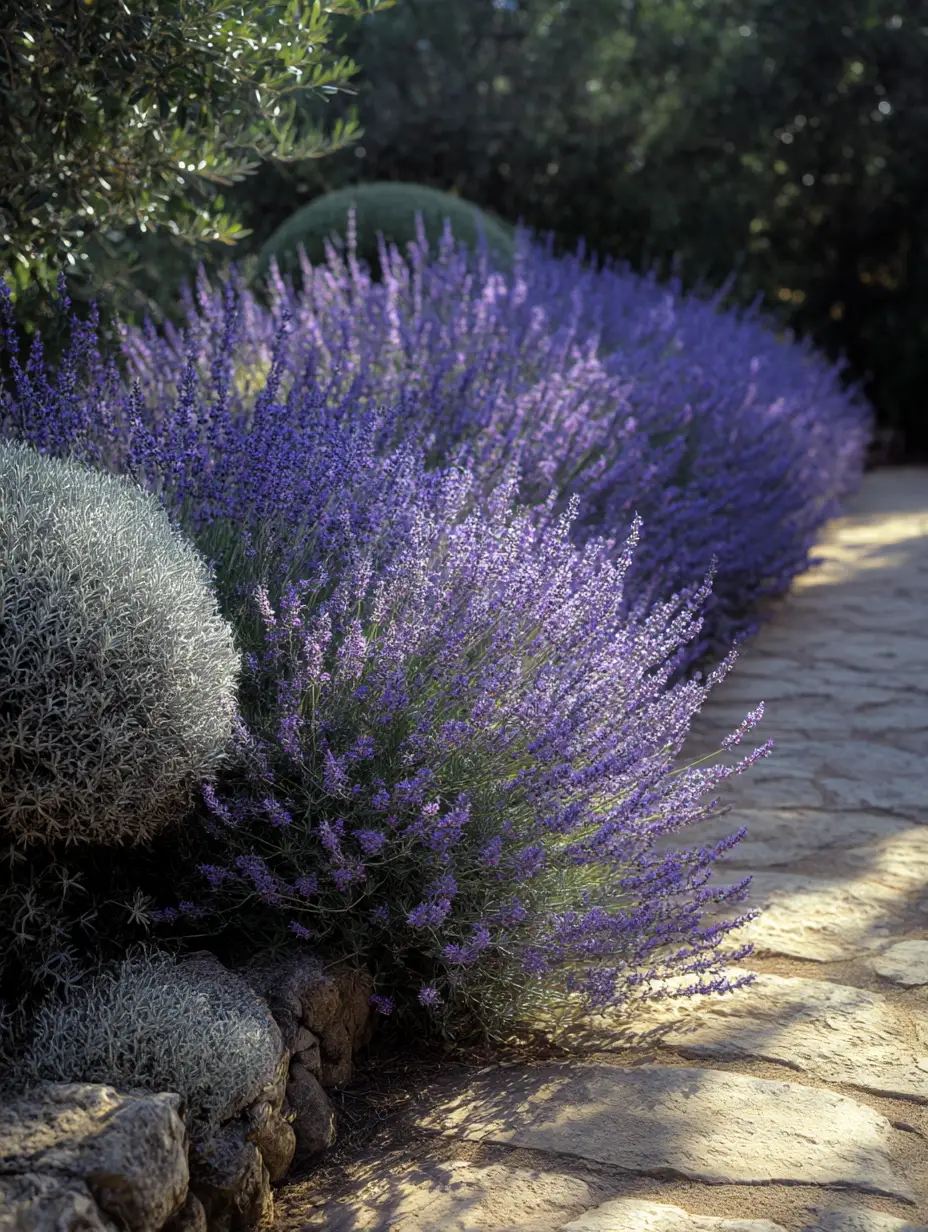
🌱 Taxonomy and origin
Botanically, “lavender” refers to plants in the genus Lavandula, which comprises around 45 known species of flowering shrubs. All lavender species belong to the mint family (Lamiaceae), sharing the characteristic square stems and aromatic oils typical of that group. Lavender is native to the Old World, with a natural range across the Mediterranean region (including southern Europe, North Africa, and parts of western Asia). In those dry, sunny habitats, wild lavender thrives on rocky hillsides and open slopes with poor soil. The plant’s name comes from the Latin verb lavare, meaning “to wash,” reflecting how ancient Romans and Greeks used the fragrant flowers in baths and laundry. Over the centuries, lavender spread far beyond its native lands. It was introduced to Britain by the Romans and became a staple of monastery and cottage gardens. Today, the plant is cultivated worldwide, from the famous purple fields of Provence in France to home gardens across North America, valued for both its ornamental beauty and its long history of medicinal and aromatic use.
🌸 Bloom time
Lavender typically blooms during the warm months, bringing its colorful spikes into flower from late spring through summer. The exact bloom time varies by species and climate. In many regions, English lavender (Lavandula angustifolia) starts flowering in late spring to early summer (often around June), while hybrid lavandins (Lavandula × intermedia) and other types peak a few weeks later in mid-summer. Spanish lavender (Lavandula stoechas), known for its tufted “rabbit ear” bracts, may begin blooming as early as mid-spring in mild areas. Most lavender plants flower for several weeks, and with proper deadheading (removing spent blooms), some varieties can produce a second, lighter flush in late summer or early fall. In the garden, lavender’s bloom period helps bridge the gap between seasons: its early summer display arrives after spring bulbs and irises fade, and overlaps with the first flush of roses and other mid-season flowers. With plenty of sunshine, the lavender blossoms will last for weeks on the stems, attracting bees and adding continuous color and fragrance to the summer landscape.
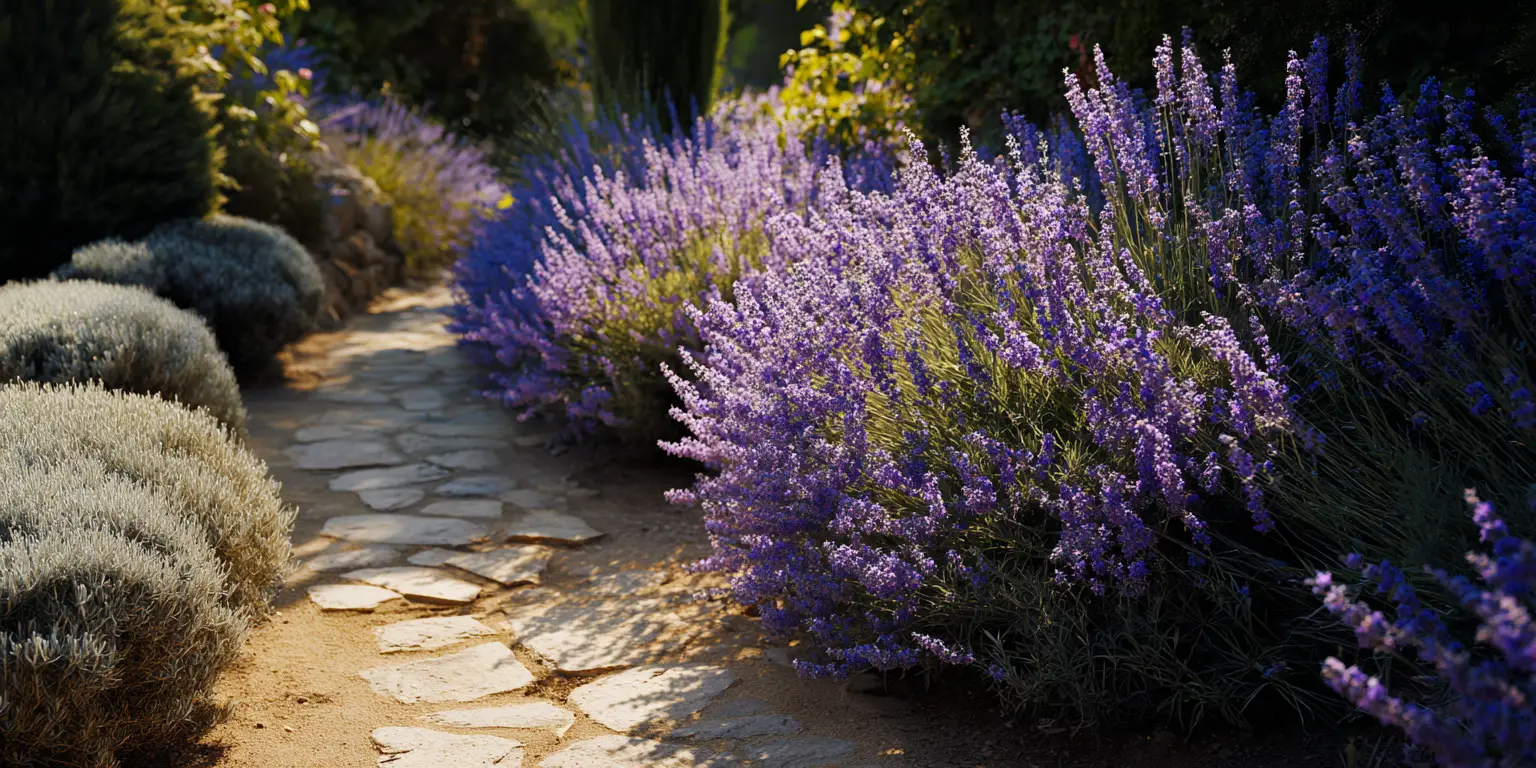
📏 Height and spread
Lavender plants form compact shrubs that are moderate in size. On average, a mature lavender will reach about 1 to 3 feet in height (30 to 90 cm) and a similar span in width, though exact size depends on the variety. Dwarf or compact cultivars might stay just around 12 inches tall, whereas vigorous hybrid varieties (like some lavandins) can grow towards the upper end of that range, especially in ideal conditions. The growth habit is typically a bushy mound of woody stems with many upright flower stalks emerging above the foliage. As lavender plants age, their bases become woody and thicker, while the upper stems remain slender and bear the leaves and flowers. Gardeners often trim or shape lavender annually to maintain a neat form and prevent excessive woodiness at the center. With occasional pruning, a healthy lavender will keep a pleasing rounded shape. It’s a medium-sized shrub that fits nicely in borders, along paths, or grouped into a fragrant low hedge, without overpowering neighboring plants.
☀️ Light
Plenty of sun is essential for lavender to thrive. In fact, lavender grows best in full sun conditions. This means selecting a planting spot that receives at least 6 to 8 hours of direct sunlight per day. Under bright sun, lavender plants maintain a compact form and produce more abundant blooms. In contrast, in partial shade or overly cloudy environments, the plants may stretch (become leggy) and flower less, compromising their beauty and health. Lavender’s Mediterranean heritage has accustomed it to intense sunlight and high temperatures, so it can handle hot afternoon sun in stride. In extremely hot desert climates, providing a little bit of afternoon shade can prevent scorching, but generally the rule is: the more sun, the better for lavender. When planning a garden layout, it’s wise to place lavender in open areas away from taller, shade-casting plants. For example, avoid planting it in the shadow of larger shrubs like camellia or under tree canopies, since too much shade will reduce its vigor. Giving lavender ample sunshine ensures it will reward you with dense foliage and plentiful flower spikes.
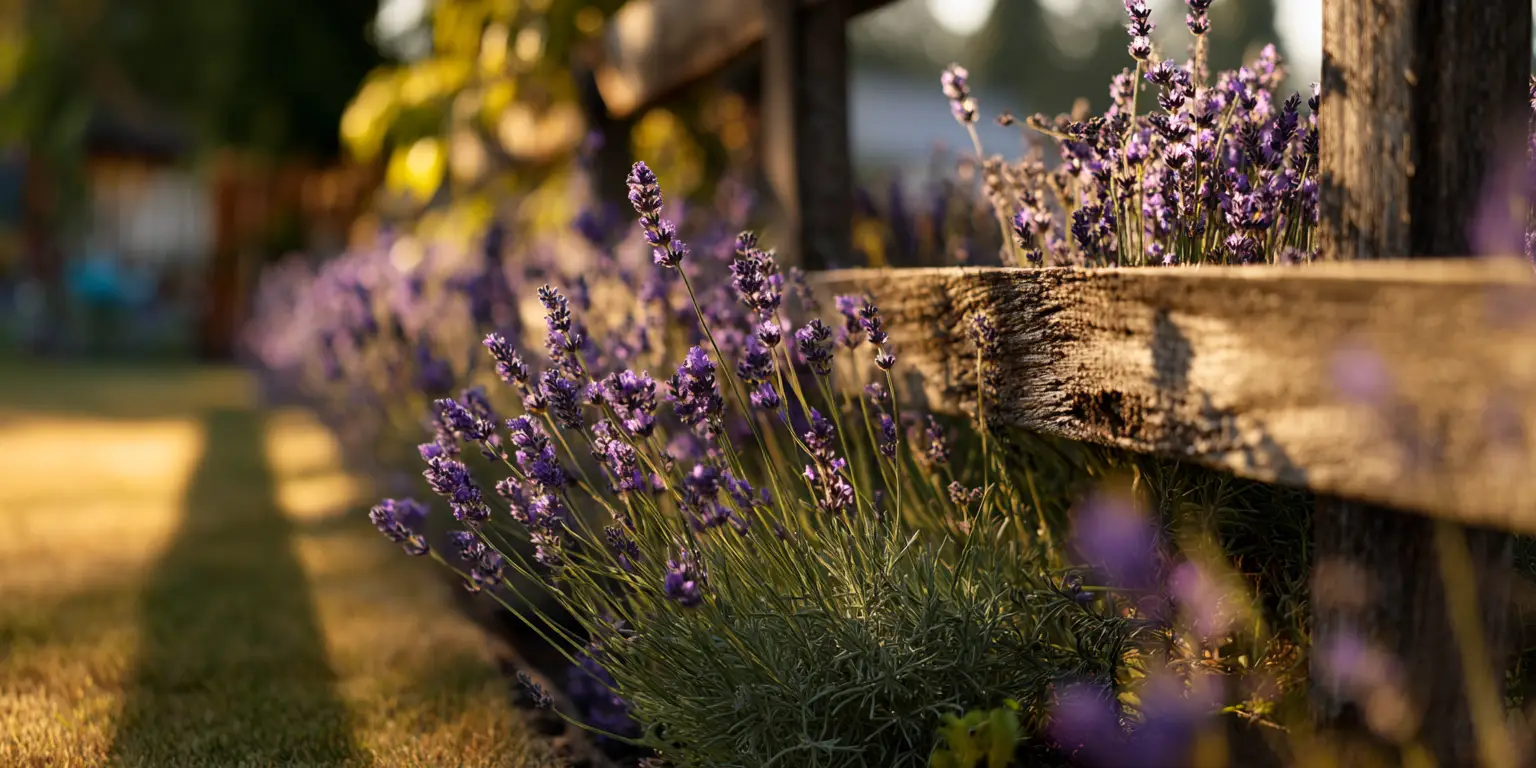
💧 Water
Lavender has low to moderate water needs, and it prefers growing conditions on the drier side. As a young plant, it should be watered regularly to help establish a deep root system (watering when the top inch of soil has dried). However, once established, lavender is quite drought-tolerant. In fact, overwatering is a common cause of problems: consistently soggy soil can lead to root rot and other fungal issues. It’s best to let the soil dry out between thorough waterings. In most climates, natural rainfall often suffices for mature lavender, except during prolonged droughts or extreme heat waves. When watering is needed, soak the ground deeply at the base of the plant rather than sprinkling from above, since wet foliage in humid weather can invite disease. A good guideline is to mimic the plant’s native conditions: think infrequent but generous rainstorms rather than constant moisture. In containers, ensure pots have drainage holes and avoid letting them sit in water. Overall, lavender thrives on a “less is more” approach to watering. This easygoing regimen makes it a low-maintenance companion in the garden, especially compared to thirstier flowering shrubs like hydrangea macrophylla that demand frequent moisture.
🌍 Soil and pH
Proper soil conditions are crucial for lavender’s health. Most of all, lavender needs excellent drainage. Wet or waterlogged soil will quickly lead to root rot. In its native Mediterranean habitat, it grows in poor, rocky or sandy ground, so try to mimic those conditions. A gritty or sandy loam that drains fast is ideal. If you have heavy clay, consider raised beds or mix gravel and coarse sand into the earth to improve drainage. Not much fertility is required, in fact, overly rich soil can cause lush foliage with fewer flowers. Lavender actually prefers moderate to lean soil. Regarding soil chemistry, it does best in neutral to slightly alkaline conditions (around pH 6.5 to 7.5). If your garden is very acidic, add lime to raise the pH into a suitable range. Growing lavender is essentially the opposite of tending acid-loving plants like rhododendrons or camellias. Instead of peat moss or acid fertilizer, lavender benefits from a bit of lime or crushed eggshells to keep the soil “sweet” (alkaline). The goal is a dry, airy soil environment that mimics a sunny, rocky hillside, ensuring the roots stay healthy.
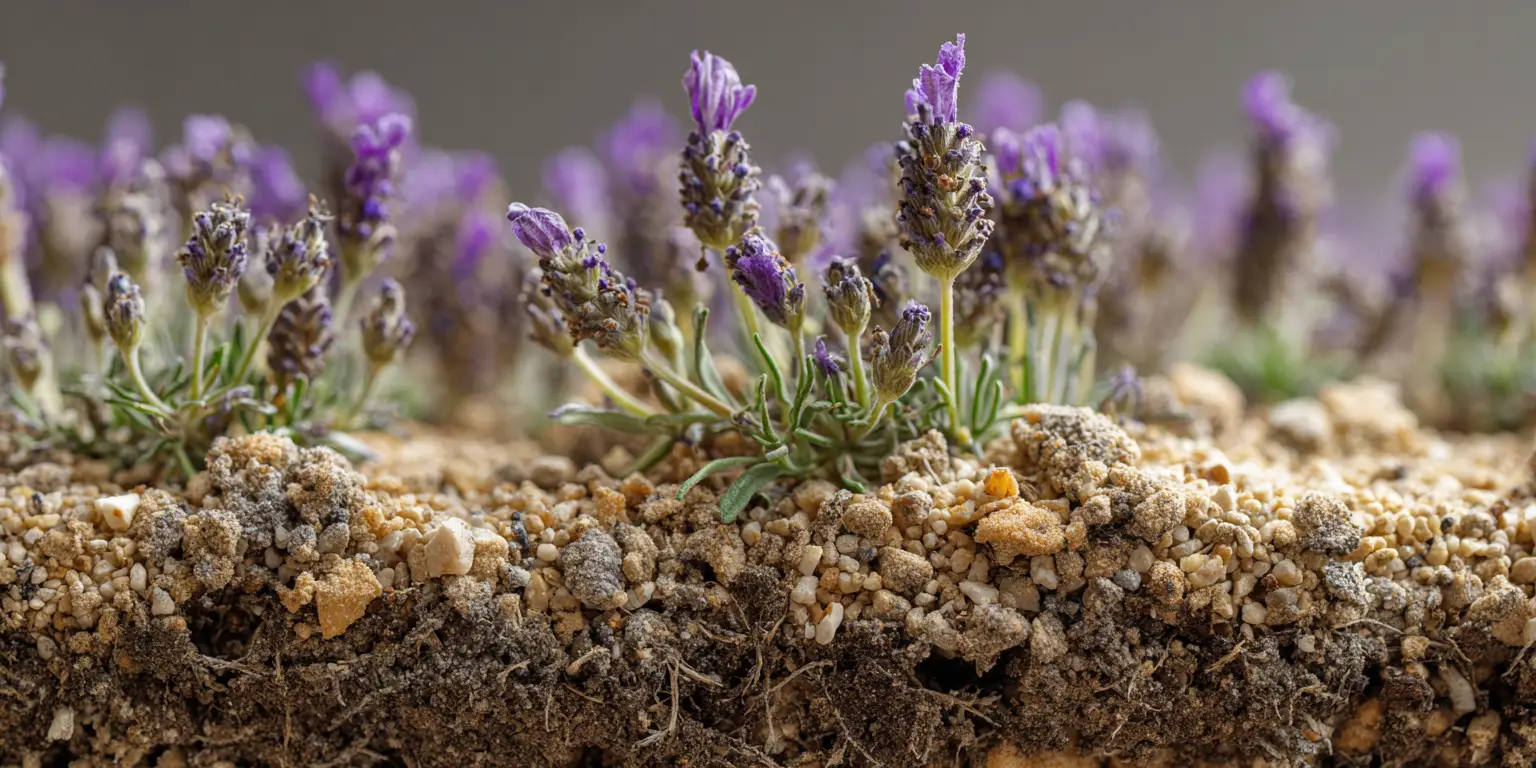
❄️ USDA hardiness
The ability of lavender to survive winter cold depends on the species and variety. Generally, the most cold-hardy lavenders are the English lavender types (Lavandula angustifolia) and some hybrid lavandins, which can typically tolerate down to about USDA Zone 5. This means they survive winter lows around -10°F (-23°C) when grown in well-drained soil. There are even a few particularly hardy selections (such as the cultivar ‘Phenomenal’) that have been known to overwinter in Zone 4 conditions with protection. In contrast, French and Spanish lavenders (such as Lavandula dentata and Lavandula stoechas) are more tender, usually hardy only to Zone 7 or 8. Gardeners in colder climates often treat those types as annuals or grow them in pots that can be moved indoors during freezing weather. If you live near the edge of lavender’s hardiness range, there are a few strategies to help plants survive winter: plant in a sheltered spot with good drainage, apply a loose mulch (like straw or evergreen boughs) after the ground freezes to insulate roots, and avoid pruning too late in the season. With the right variety selection for your zone and a bit of winter protection, lavender can be a perennial fixture in many temperate gardens.
🌼 Propagation and longevity
Lavender can be propagated in several ways, though some methods are more effective than others. Growing from seed is possible, especially for species lavender, but keep in mind that seeds can be slow to germinate and offspring may not come true to the parent plant if it’s a hybrid cultivar. Because of this, many gardeners prefer vegetative propagation for lavender. The most common method is by taking cuttings. Softwood cuttings (fresh, green stem tips) or semi-hardwood cuttings taken in summer can root successfully. A 3-4 inch stem tip placed in a loose, sandy potting mix will often develop roots within a few weeks when kept humid but not overly wet. Propagating by cuttings ensures the new plants are clones of the parent, preserving desirable traits like flower color or compact form. Lavender can also sometimes be propagated by layering (bending a low branch to the ground and covering a portion of it with soil until it roots), though this is a slower technique.
In terms of longevity, lavender is a perennial but not an exceptionally long-lived one compared to some other shrubs. An individual lavender plant typically remains vigorous for around 10 to 15 years under good care. English lavender varieties tend to have the longest lifespans, often a decade or more if pruned correctly and grown in ideal conditions. In contrast, the less hardy French and Spanish lavenders might only last 5 to 7 years before becoming woody and declining. Over time, even well-tended lavender will get woody in the center and produce fewer flowers. Gardeners often replace very old lavender plants with new ones grown from cuttings to keep a planting looking fresh. Regular pruning and avoiding winter damage can maximize the lifespan of a lavender, but eventually a renewal planting may be needed. Still, a healthy lavender shrub can grace a garden for many seasons, offering its fragrance and blooms year after year.
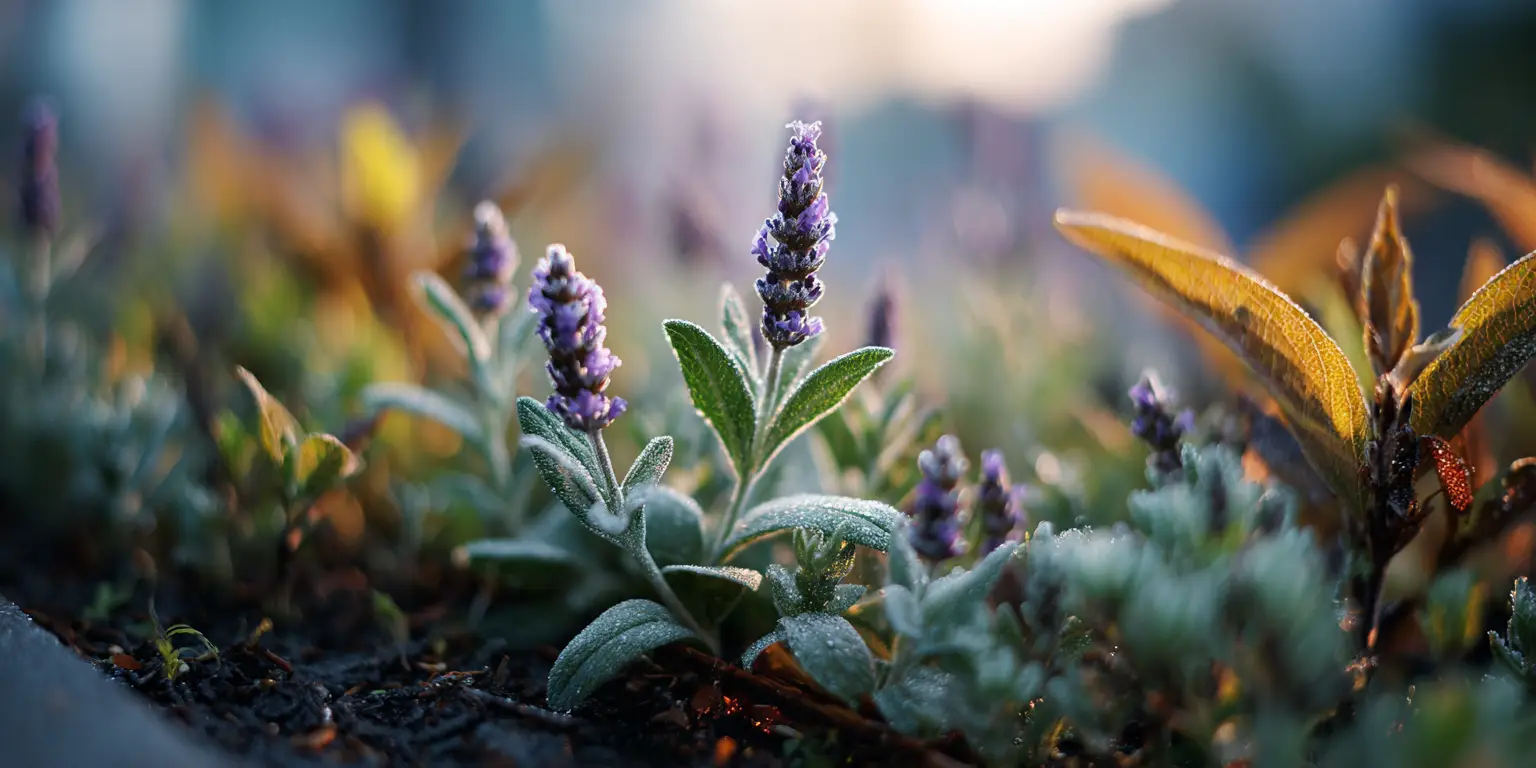
👃 Fragrance
One of the most famous attributes of lavender is its delightful fragrance. Both the flowers and the foliage contain aromatic oils that give off a fresh, sweet herbal scent often described as calming or relaxing. Many people find that simply brushing against a lavender plant releases a pleasing cloud of aroma. The chemistry behind the scent comes from compounds like linalool and linalyl acetate, which are abundant in lavender’s essential oil. These oils have made lavender a staple in perfumes, soaps, sachets, and aromatherapy products for centuries. In the garden, the fragrance is not only enjoyable for people but can also benefit the environment around the plant. The scent tends to attract pollinators such as bees, butterflies, and other beneficial insects, making it a great plant for pollinator-friendly gardens. On the flip side, the same aromatic compounds help repel certain pests. For example, mosquitoes, moths, and flies are reputed to dislike the smell of lavender, which is why dried sprigs are sometimes used to keep closets and linens fresh. Placing lavender near patios or doorways may offer a gentle deterrent to biting insects while perfuming the air. Overall, fragrance is central to lavender’s appeal, linking the plant’s ornamental beauty with practical uses and sensory enjoyment.
⚠️ Toxicity and pet safety
Gardeners with pets (or curious children) often wonder if lavender is safe to grow. In general, lavender is not harmful to touch or smell. Brushing against the plant or inhaling its scent is harmless to people and usually pleasant. However, if parts of the plant are actually eaten, there are some concerns. Lavender contains compounds like linalool and linalyl acetate that are mildly toxic to certain animals. The ASPCA lists lavender as toxic to dogs and cats because eating a substantial amount could cause digestive upset (such as vomiting or diarrhea) or sedation. Fortunately, cases of serious poisoning are very rare. Most pets instinctively avoid strongly scented plants, and the concentration of those compounds in the leaves and flowers is low. Nonetheless, pet owners should exercise caution: try to prevent cats or dogs from nibbling on your lavender bushes, and be especially careful to keep bottles of lavender essential oil out of reach. The highly concentrated oil can pose a greater risk if spilled or applied to an animal’s skin.
For humans, lavender is generally considered safe. In fact, English lavender is sometimes used as a culinary herb in small quantities (for example, to flavor teas, syrups, or baked goods). Touching the plant is not irritating for most people, aside from rare allergic skin sensitivities. Of course, as with any herb, ingesting extremely large amounts is not advised, as it could cause stomach discomfort. Normal use in cooking or as an herbal remedy (like lavender tea) is fine. Overall, having lavender in the garden or home is usually pet-friendly and family-friendly, as long as common-sense precautions are taken (i.e. discourage your animals from chewing on the plants). If a pet did consume a large portion of a lavender plant and shows unusual symptoms, consult a veterinarian to be safe
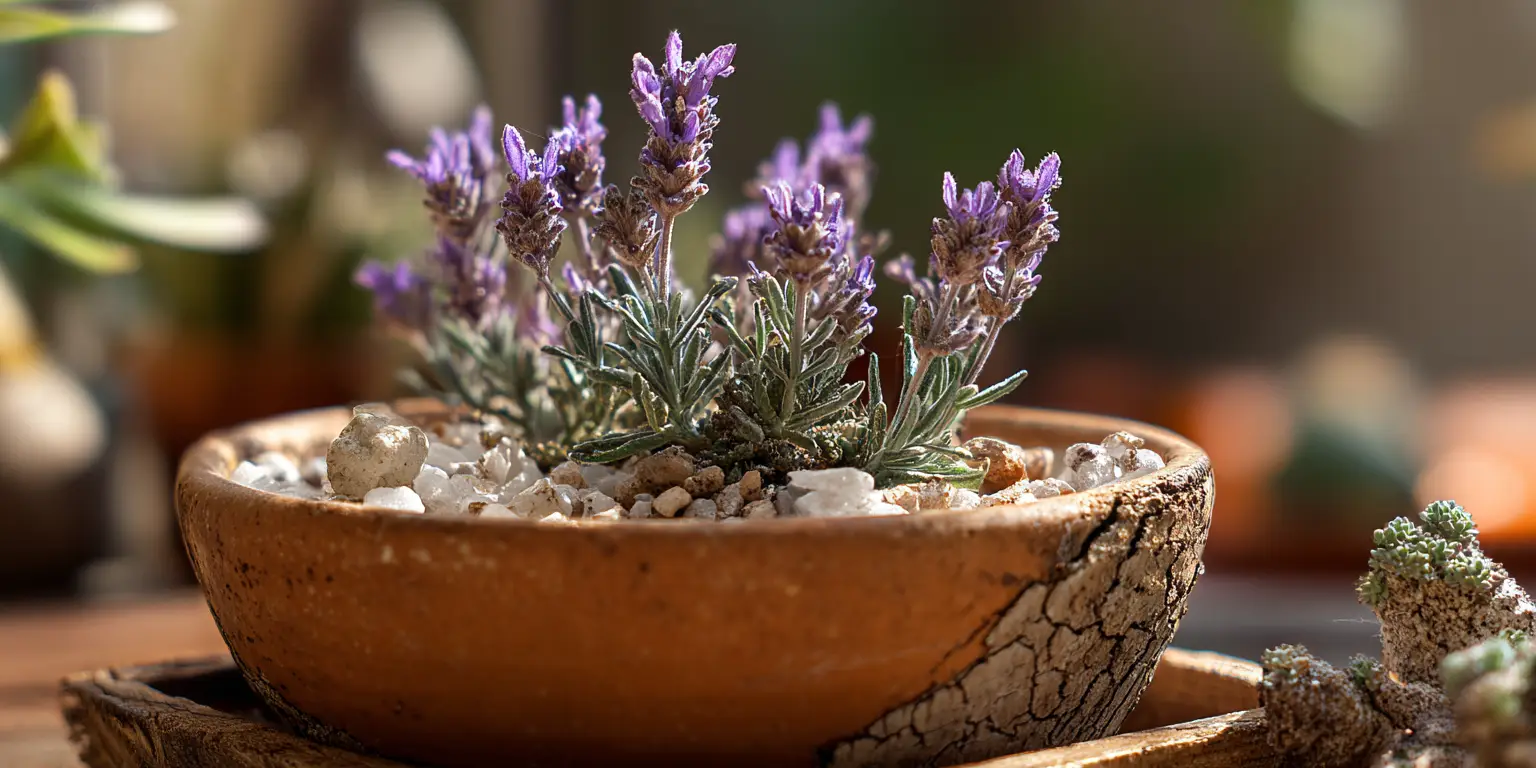
🌿 Vase life
Lavender is often enjoyed not just on the plant, but also as a cut flower, both fresh and dried. If you cut fresh lavender stems and place them in a vase of water, the blooms will usually last around 5 to 7 days before they start to wilt and fade. That vase life is moderately short compared to some other popular cut flowers (for instance, roses or a sunflower can often remain vibrant for over a week). To make the most of fresh-cut lavender, it’s best to harvest stems when a good number of the florets on each spike have opened but some buds still remain. This way, the display will continue in the vase as a few more buds open over time. After cutting, immediately place the lavender stems in water and keep the vase in a cool spot out of direct sunlight. Changing the water daily can help extend their freshness by another day or two.
Where lavender truly shines is as a dried flower. Unlike many blooms that quickly shatter or lose their charm when dried, lavender retains much of its color and fragrance for a long time. Many gardeners and crafters hang lavender bunches upside-down in a dark, airy place for about two weeks to dry them completely. Once dried, the stems can last for months or even years in arrangements, sachets, or potpourri while still looking attractive and smelling wonderful. In other words, a fresh lavender bouquet may be short-lived, but it seamlessly transitions into a long-lasting dried bouquet that keeps the essence of the flower alive well beyond its fresh vase life.
🐛 Pests and diseases
Lavender is known as a relatively problem-free plant in the garden. Its strong aromatic oils tend to make it unappealing to many browsing animals and insect pests. For example, deer and rabbits typically leave lavender alone, which is a nice bonus for gardeners in areas where those critters roam. In fact, planting lavender near more vulnerable plants (like tulips or lettuce) may help deter grazing by these animals. In terms of insects, only a few bother lavender. You might occasionally notice spittlebugs (cuckoo spit), which leave little white foamy blobs on stems. These pests suck sap, but they rarely cause significant harm and can be washed off with a spray of water. Aphids sometimes gather on tender new growth in spring, but infestations are usually small and can be managed by rinsing them off or letting natural predators (like ladybugs) do the work. Another minor pest is the four-lined plant bug, which can create small round spots on lavender leaves in early summer. Fortunately, the damage is cosmetic and doesn’t seriously affect the plant’s health.
The more serious problems for lavender tend to be diseases – particularly fungal issues related to excess moisture. Because lavender cannot tolerate soggy soil, root rot is the most common threat. Fungal pathogens in poorly drained conditions (such as Phytophthora or Pythium species) can cause roots and the plant’s base to rot, leading to wilt and dieback. Plants affected by root rot may yellow or wilt despite moist soil, and often do not recover. Preventing this starts with excellent drainage and careful watering (never let lavender sit in waterlogged soil). Another disease to watch for is lavender “shab,” caused by the fungus Phomopsis lavandulae. This infection causes entire stems to turn brown, wither, and die, often with tiny black specks (fungal fruiting bodies) on the stems. If lavender shab appears, immediately prune out and dispose of the affected stems, in severe cases the whole plant should be removed to protect other nearby lavender. Additionally, in very humid or wet weather, lavender can develop leaf spots or gray mold (botrytis) on spent flowers. Good airflow around the plants, proper spacing, and keeping the foliage as dry as possible help prevent these problems. By choosing a suitable site and meeting lavender’s preferred dry conditions, you can avoid most issues. In fact, thanks to its natural pest-repelling fragrance and low water needs, lavender typically encounters far fewer problems than fussier plants in the garden.
FAQs
Is lavender a perennial or an annual plant?
Lavender is a perennial shrub in most regions. If you plant a lavender in the ground and it’s appropriate for your climate, it will come back year after year. Most common lavenders (such as English lavender) are hardy in USDA Zones 5 to 9, meaning they can survive winter cold and regrow each spring. In colder zones, lavender may not survive the winter outdoors, so some gardeners treat it as an annual or keep it in a pot to bring indoors during freezing weather. But in the right conditions, lavender is a long-lived perennial that will bloom each summer for many years.
Can lavender grow in pots or indoors?
Yes, lavender can be grown successfully in pots, and even indoors with the right conditions. In fact, container growing is a good option if your native soil is not ideal or if you want to overwinter plants in a cold climate. Use a pot with drainage holes and a gritty, well-draining potting mix (you can mix in sand or perlite to improve drainage). Place potted lavender in a location that receives full sun. Outdoors on a sunny patio is perfect. If growing indoors, give it as much direct light as possible (a south-facing window is best, or supplement with a grow light). Ensure good air circulation to avoid humidity build-up around the foliage. Be careful not to overwater potted lavender, water only when the top inch of soil is dry. With proper care, lavender can thrive in containers and bring its fragrance to porches, balconies, or indoor spaces.
When and how should I prune my lavender?
Regular pruning keeps a lavender plant neat and encourages it to live longer. The best times to prune are right after the main bloom flush, and again lightly in spring. In mid to late summer, once your lavender finishes flowering, you can trim back the spent flower stalks and shape the plant, generally cutting off the top couple of inches of growth, but not into the old wood. This “deadheading” tidies the plant and sometimes promotes a bit of late-season rebloom on certain varieties. The more significant prune is in spring (around early to mid-spring as new growth appears). At that time, remove about one-third of the overall height of the plant, shaping it into a mound. Make sure to leave some green growth on each stem, do not cut deep into bare woody parts because those might not sprout new growth. By pruning annually, you prevent the lavender from getting too leggy or woody, and you’ll help it produce plenty of fresh shoots and flowers.
Why is my lavender not flowering?
If your lavender plant looks healthy but isn’t producing blooms, a few factors could be at play. First, check the sunlight. Lavender needs full sun (at least 6 hours a day). A plant in too much shade will have sparse flowering. Next, consider fertilizer and soil: lavender actually blooms better in lean soil. If it’s in very rich soil or has been given a lot of high-nitrogen fertilizer, it might be growing lush leaves at the expense of flowers. Overwatering or poor drainage can also stress the plant and reduce blooming. Additionally, improper pruning could be an issue. If lavender is cut back too hard or at the wrong time (for example, cutting off all the developing buds), it may skip a bloom cycle. Lastly, ensure the plant is mature enough and of a blooming variety (lavender grown from seed can sometimes take a year to really start blooming heavily). By providing lots of sun, avoiding overfeeding, and pruning correctly, your lavender should reward you with flowers.
Does lavender attract bees or other pollinators?
Absolutely. Lavender is well known as a pollinator-friendly plant. When it’s in bloom, you’ll often see honeybees, bumblebees, and butterflies flitting around the purple spikes. The flowers produce nectar and pollen that many insects find irresistible. This makes lavender a great choice for pollinator gardens – it provides food for beneficial insects while you get to enjoy the sight and scent of the blooms. In addition to bees and butterflies, lavender’s scent can also attract hummingbirds in some regions. So, by planting lavender, you’re likely to see an increase in friendly garden visitors. Plus, the abundance of pollinators will help out any other blooming plants nearby.
Will deer or rabbits eat my lavender?
Generally, no. One of the perks of lavender is that it’s deer-resistant and rabbit-resistant. The foliage has a strong aroma and a somewhat bitter taste that usually deters browsing animals. Deer and rabbits tend to prefer softer, less fragrant plants to munch on. While nothing is absolutely deer-proof if food is scarce, lavender is typically one of the last things they’ll try to eat. Many gardeners use lavender as a border plant around more susceptible flowers to help ward off grazing. If you have a lot of deer or rabbits, lavender can be a smart choice to plant, as you likely won’t find your plants nibbled down to stems.
Can I cook with lavender or use it in food and drinks?
Yes, lavender is edible and is used culinarily, though in moderation. The most commonly used type for cooking is English lavender (Lavandula angustifolia), because it has the sweetest fragrance and flavor, with less of the medicinal or camphor note that some other species have. You’ll find recipes that include dried lavender buds in cookies, cakes, or lemonades, and lavender is one of the herbs in the classic Herbes de Provence blend for savory dishes. The key is to use only a small amount, because the flavor is very potent. Even a little can impart a pleasant floral note, but too much can make food taste perfumey. Always make sure any lavender used in food hasn’t been sprayed with chemicals. You can dry your own lavender from the garden for culinary use. A few dried flower buds can be steeped to make a calming tea as well. So while lavender is not a staple herb like basil or rosemary, it certainly has its place in the kitchen for adventurous cooks.
What’s the difference between English, French, and Spanish lavender?
These names refer to different species (or groups) of lavender, each with its own characteristics. English lavender usually means Lavandula angustifolia. Despite the name, it’s not native to England (it came from the Mediterranean), but it earned that nickname because it grows well in the English climate. English lavender is the most cold-hardy and typically has the classic sweet lavender fragrance. It blooms in late spring to early summer and has slender spikes with compact purple flowers. French lavender often refers to Lavandula dentata (sometimes people also lump L. stoechas in as “French”). It has a longer bloom season (in warm climates it can bloom repeatedly), and its leaves are serrated (toothed edges) and very fragrant, with a slightly different scent (some describe it as more pine-like). French lavender is less cold tolerant (around Zone 8 and up). Spanish lavender refers to Lavandula stoechas, known for its distinctive flower heads with showy bracts (the “rabbit ears” or “butterfly” petals on top of the flower spike). Spanish lavender often blooms earlier (spring) and can bloom off and on. It has a strong fragrance but more camphorous, and it’s also not very cold hardy (Zone 7-8 and up). In summary, English lavender is best for cooler climates and has the traditional look and smell, French and Spanish lavenders thrive in mild climates, have a longer bloom period, and feature different flower forms (especially the Spanish with its tufted bracts). There are also hybrid lavenders (Lavandins) which are crosses of different species, combining traits of English and other types. Those tend to be larger plants that bloom in mid-summer with excellent fragrance (often grown for oil production), though they are slightly less hardy than true English lavenders.
Is lavender used in weddings and bouquets?
Yes, lavender is quite a popular choice for weddings, especially for rustic, garden, or vintage-themed ceremonies. The plant carries symbolism of purity, devotion, and serenity, which makes it meaningful for marriage celebrations. Fresh sprigs of lavender are often included in bridal bouquets, bridesmaid posies, and boutonnieres, adding a lovely fragrance and a touch of casual elegance. Lavender can also be used dried as confetti (for guests to toss) or as fragrant decorations tied into favors. Its soft purple color complements many other blooms and fits well with romantic color schemes. Because of its seasonal availability in summer, lavender shows up frequently in outdoor summer weddings. For more ideas on incorporating flowers into wedding decor, couples often consult a wedding flowers guide for inspiration and planning.
Interesting tips
- Color Combinations: Lavender’s cool purple hue plays well with other flowers. For example, in spring, low-growing forget-me-nots can carpet the ground in blue beneath emerging lavender shoots. As summer arrives, the purple spikes of lavender blend beautifully with other blue flowers like catmint or salvia. This creates a soothing monochromatic palette in the garden. You can also contrast lavender with yellow or orange blooms for a pop of complementary color.
- Natural Pest Repellent: Take advantage of lavender’s natural oils by drying the flowers. Place dried lavender sachets in your closet or drawers. They will help repel moths and keep fabrics smelling fresh. Historically, people scattered lavender on floors or kept sprigs among linens to deter insects. Even today, planting lavender near doorways or seating areas may reduce mosquitoes and flies in that area while perfuming the air.
- Choose the Right Variety: Always select a lavender type suited to your climate. If you live in a region with harsh winters, opt for English lavender or an extra-hardy cultivar (some are bred to survive colder temperatures). In warmer climates, you can grow French or Spanish lavender, which will reward you with nearly year-round blooms. Matching the lavender variety to your zone will ensure your plants come back each year. When in doubt, check the plant’s labeled USDA hardiness range before buying.
- Mediterranean Herb Partners: Lavender makes a great companion in drought-tolerant landscapes. Consider planting it alongside other sun-loving herbs and perennials that thrive in similar conditions. A classic combination is lavender with rosemary, thyme, and sage. Together they create a fragrant Mediterranean herb garden that needs very little water or fuss. Ornamental grasses, santolina, or succulents can also complement lavender’s texture and fill in the landscape for a beautiful, low-maintenance design.
- Harvesting for Fragrance: To get the most fragrance out of your lavender, time your harvest wisely. The best time to cut lavender stems is in the late morning on a dry day, after any dew has evaporated but before the strongest midday sun. This is when the essential oil concentration in the flowers is highest. Use sharp pruners and cut just above a leaf node. Gather bunches and hang them upside down in a dark, ventilated place to dry. In a week or two, you’ll have wonderfully aromatic dried lavender for crafts, sachets, or arrangements.